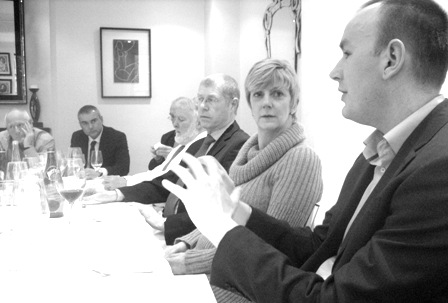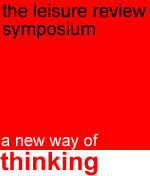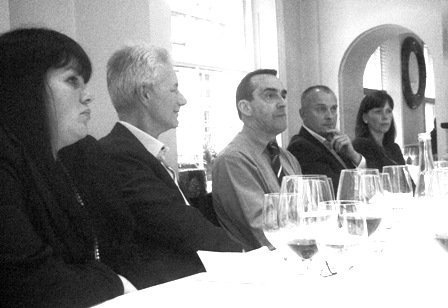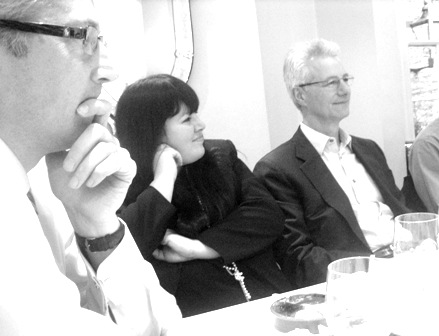The opening question posed to the assembled summit of swimming experts was whether the sector could reasonably expect swimming to sink or swim. Given a national commitment to swimming that goes back over 150 years, should we not have found more cost-effective ways to do what swimming does? Should we not be able to build facilities and management models that do not require swimming to be subsidised? And is it time to revisit the way we teach and coach swimming to meet the demands of recreation, development and competition in the 21st century?
John Eady, managing director of leisure specialists KKP and facilitator for this discussion, posed the initial question and the initial response was that there may well be too many pools in this country. Surveys show that participation in swimming has dropped and that ageing facilities are increasingly difficult to maintain. However, the point about participation was quickly countered by operators whose pools show no signs of falling use. As one operator noted, fitness swimming is increasing and children’s session during school holidays are always busy: “If you’ve got a good pool, it’s packed. If numbers are dropping it’s our fault. The fitness business has always been customer focused but in comparison swimming is still a rough environment.”
The drop in participation has been demonstrated by an ISPOS-MORI poll commissioned by the ASA and by the Active People survey; local authority figures also apparently illustrate the point. However, with fitness swimming still popular and a number of operators reporting a high uptake of children swimming for a pound, there still seems to be significant demand. By way of example, one London borough that organised sessions for Muslim women reported queues round the block hours ahead of the session. It was noted that the latent market for adult swimming had been demonstrated by the free swimming initiative, during which it was revealed that some 20% of adults cannot swim. As a result adult swimming lessons are popular when they are offered and many felt that structured sessions would prove more attractive to adult swimmers, even though most local authorities still insist on a high proportion of casual swimming sessions in the programme.
Some around the table wondered why the culture of gym operation could not be introduced to the pool. It would require a significant change of culture but it could provide a different, high-quality experience for which some people would be prepared to pay a premium. With 75% of the UK’s pool stock in local authority ownership, such a change might prove challenging but the recent comprehensive spending review had at least provided the impetus for many local authorities to think what had previously been unthinkable in terms of service provision.
This quickly brought the debate onto the afternoon’s second theme, the funding of swimming facilities. With recent innovations and interventions showing that pools can be managed to generate revenue is subsidising swimming as a leisure activity still valid? Taking it as read that no one was advocating a return to selling tickets for first, second and even third use of the baths water, the point was made that few detailed statistics on the extent of the subsidy to swimming were currently available and that many of the people at whom subsidies were primarily aimed, essentially the economically disadvantaged, were still unable to afford the swimming experience. Some operators pointed to entrenched ideas among client officers about how swimming facilities should be managed and their time programmed. A fear of change seemed high on the list of problems, although the free swimming initiative had, for all its flaws, changed mindsets in some areas.
The facilities themselves were felt by a number of contributors to be central to the problem. Many local authorities had ridden the wave of popularity that leisure pools had enjoyed in the 1980s and 90s but they had proved expensive to manage and maintain; it was noted that only two still operate in the whole of London. Swimming facilities have to be improved to attract regular swimmers but the investment was increasingly hard to come by even before the government’s assault on public spending. It was also suggested that a worrying number of facilities are still being built without sufficient thought to cost-effective management. Why, for example, would one recent project end up with three different sets of changing rooms for wet and dry activities spread around the building? One contributor involved in construction lamented the limited expectations of his clients: “We need to provide high-quality services but many of our customers still want a pool similar to the sort of thing we were building 40 years ago.”
It was noted that, while no authority wants to close a pool, in the current economic climate it is hard to defend the investment in swimming facilities when participation is declining. Manchester is closing a number of its pools and it will not be the only local authority so to do. One contributor wondered whether swimming should be “properly free”, noting that “this would be a different debate if we were talking about museums”. However, when one can visit a pool in the middle of the day, as one contributor had recently done, to find two people swimming watched by two lifeguards, one has to wonder at the viability of the service being offered: “There is a cost to the expectation that swimming pools will be open whenever we want to use them.”
Having been touched upon, the issue of lifeguarding in swimming pools was swiftly picked up around the table. Lifeguarding, it was agreed, was important on so many levels, not least that it represents a significant proportion of the cost of running a swimming pool. One operator offered some figures to support the point: the company spends some £10 million a year on lifeguards and runs approximately 4% of the pools in the UK. A simple extrapolation of these figures illustrates the scale of the costs incurred nationally. However, contrast that with a visit to a pool in Germany, for example, where one might find a single trained lifeguard on duty in a large, multi-pool facility, reflecting a different approach to attitudes to personal safety. Corporate manslaughter legislation in the UK had recently served to highlight the legal complexities of the lifeguarding issue and, it could be argued, health and safety legislation is working against making swimming affordable. School sessions might need lifeguarding but clubs and adult lane swimming may not. It was noted that although anyone using a gym is usually subjected to a health questionnaire, anyone using a swimming pool does so at their own risk, at least in terms of their fitness to swim.
Representatives of the STA concurred and explained that while discussions were being held with the Health and Safety Executive (HSE) conversations were extremely complicated and consequently slow to progress. Any change to the regulations applied to lifeguarding will need a concerted industry approach and a means to solve any problems raised by an easing of lifeguarding regulations; teaching people to swim would, of course, be an important aspect of any solution. From an operator’s perspective, any advocacy of people accepting risk for themselves is fraught with danger. Any change of safety culture would require a change to the industry guidelines, which at present are defined by the HSE regulations and the publication Managing Health and Safety in Swimming Pools. Any change to these would require the industry to go to the HSE with a single voice and good grounds for a review. This, it was suggested, could offer the new professional body formed from the merger of the ISRM and ISPAL its first worthwhile project.
It was quickly agreed round the table that any discussion of changes to health and safety regulations could not be couched in terms of cost if it were to have any hope of success but that the cost of swimming was a genuine issue if swimming is to remain central to the nation’s leisure provision. As one operator noted, we all want to get children swimming but the revenue does not cover costs; revenue is generated by adults, whether by local authorities specifically subsidising swimming programming or via cross-subsidies from adult gym memberships. This prompted a reiteration of the question, why should we subsidise swimming? Answers came quickly: it is a life skill; a gateway to all other water sports; it is fundamental to personal safety around any form of urban or rural water; it uniquely ticks all the boxes of participation, life skills, physical activity and health.
But nothing costs as much as swimming to provide. How can we justify the subsidy of middle-class people accessing swimming facilities? Could some other activity or activities deliver similar benefits to individuals and communities but with a smaller subsidy? Around the table, swimming people were being asked to think the unthinkable but it crystallised debate into a differentiation of ‘learn to swim’ and ‘participation’. Should local authorities see their responsibility as teaching people to swim and then handing them over to the private sector where they can participate? A change to programming, realistic pricing, fewer but better pools and tapping a latent market demonstrated by growth in participation among older age groups could have a significant impact on revenue generation. Private sector swim companies were seeing big growth in their numbers and could generate revenue for pools in off-peak times.
The facilities themselves were felt by many around the table to be central to the issue. Energy costs were “the elephant in the room” of facility management, showing huge cost increases in recent years but do we subsidise the building when we should be subsidising the swimmer? Do we need facilities built to last or should the model be that of private sector gym provision: specifications and life spans driven by the commercial business model that will generate returns over the life of the building? Many local authority clients, it was noted, look to 50-year lifespans when a case could be made for specialist facilities, the swimming equivalent of the gym box. The ASA’s ideal facility of a 50m, 10-lane pool with two booms was generally thought to be an excellent idea that was unrealistic unless such pools were envisaged as a regional asset.
Any discussion of swimming facilities and programming will sooner or later arrive at the subject of swimming clubs and The Leisure Review swimming summit was no exception. Some noted that many clubs have prime evening sessions that could be better used to generate revenue, although the issue of young swimmers being pushed back into later time slots was acknowledged as an issue. The Shropshire Academy has been in discussion with all its clubs, outlining an agreed way forward in which the local authority takes responsibility for learn to swim while the clubs accept the role of coaching. Under this arrangement many clubs will need to adjust their business model but it will mean that they need less time in the pool. The ASA accepts the likelihood of a rationalisation of swimming clubs as a result of the government’s spending review and agrees that clubs are not necessarily the best place to teach people to swim but there is a demand for learn to swim programmes that is not being met.
With the discussion still rolling, the arrival of coffee signalled an end to the summit’s official proceedings. The original questions may not have been neatly answered but the issues of finance, facilities and access had all been addressed, often from a number of directions. It is clear that with central and local government funding facing unique pressures swimming faces a difficult future if it is to retain its status as one of the nation’s most popular and most subsidised sporting pursuits. Many in the sector have accepted that new attitudes and new business models are required. Change is not just coming: it has arrived.
The Leisure Review swimming summit was presented in association with Willmott Dixon Construction and the Swimming Teachers' Association.
The Leisure Review, March 2011
© Copyright of all material on this site is retained by The Leisure Review or the individual contributors where stated. Contact The Leisure Review for details.
Download a pdf version of this article for printing






